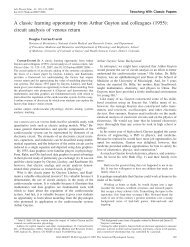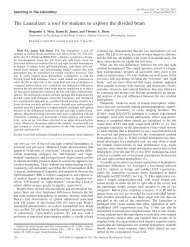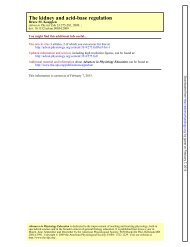construction of a model demonstrating neural pathways and reflex arcs
construction of a model demonstrating neural pathways and reflex arcs
construction of a model demonstrating neural pathways and reflex arcs
You also want an ePaper? Increase the reach of your titles
YUMPU automatically turns print PDFs into web optimized ePapers that Google loves.
I N N 0 V A T I 0 N S A N D I D E A S<br />
monosynaptic junction<br />
syna<br />
syna se<br />
sy<br />
1<br />
apse<br />
TsTv*E<br />
r<br />
receptor neuron neuron<br />
motor neuron<br />
target mkcle,<br />
organ,or gl<strong>and</strong><br />
FIG. 12.<br />
A: schematic representation <strong>of</strong> components <strong>of</strong> a <strong>reflex</strong> arc. This <strong>reflex</strong> arc schematic is for a monosynaptic<br />
<strong>reflex</strong>. BE components in a neurological schematic. Reflex arc presented in B includes an association<br />
neuron <strong>and</strong> is, therefore, a schematic for a polysynaptic <strong>reflex</strong> arc.<br />
1) Patellav tendon <strong>reflex</strong> (knee jerk <strong>reflex</strong>). The<br />
stretch <strong>reflex</strong> is the classic example used to<br />
demonstrate monosynaptic <strong>reflex</strong>es. The stretch<br />
<strong>reflex</strong> is a component <strong>of</strong> the patellar tendon <strong>reflex</strong>,<br />
but the complete patellar tendon <strong>reflex</strong> is a polysyn-<br />
aptic one.<br />
The monosynaptic component <strong>of</strong> the patellar ten-<br />
don <strong>reflex</strong> is the essential component <strong>of</strong> the <strong>reflex</strong><br />
<strong>and</strong> is diagrammed in Fig. 13.<br />
MONOSYNAPTIC STRETCH. The setup for testing this <strong>reflex</strong><br />
is very simple. Someone sits elevated with dangling or<br />
crossed legs. The patellar tendon below the kneecap<br />
(patella) is tapped with a <strong>reflex</strong> hammer. Tapping the<br />
tendon is the stimulus. Tapping the tendon causes<br />
muscle fibers in the thigh (fibers <strong>of</strong> the quadriceps<br />
muscle) to stretch very slightly. Special sensory recep-<br />
tors in the quadriceps muscle sense this stretch.<br />
The afferent neuron carries the stretch information<br />
into the spinal cord. In the spinal cord, there is a<br />
synapse between the afferent (sensory) neuron <strong>and</strong><br />
the efferent (motor) neuron. This direct afferent-<br />
efferent synapse is monosynaptic. The informa-<br />
tion carried by the efferent motor neuron causes the<br />
quadriceps muscle to contract. All <strong>of</strong> this happens<br />
automatically <strong>and</strong> very quickly, within 20 ms.<br />
Contraction <strong>of</strong> the quadriceps causes the leg to kick<br />
out. This is aided by the polysynaptic component <strong>of</strong><br />
the <strong>reflex</strong>. Note that in an anatomic sense, the leg is<br />
VOLUME 16 : NUMBER 1 - ADVANCES IN PMYSIQLOGY EDUCATION - DECEMBER 1996<br />
527









